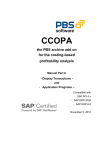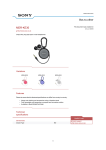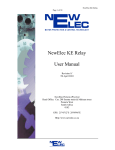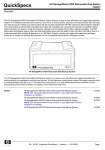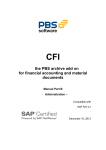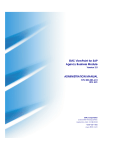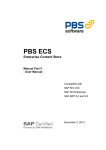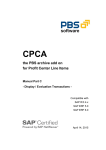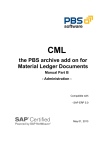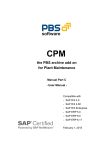Download Administration
Transcript
CCOPA the PBS archive add on for the costing-based profitability analysis Manual Part B – Administration – Compatible with SAP R/3 4.x SAP ERP 2004 SAP ERP 6.0 November 5, 2012 PBS archive add on CCOPA - Administration - 2 © 2003 - 2012 PBS Software GmbH Schwanheimer Strasse 144a 64625 Bensheim, Germany Phone: +49 - 6251 - 174 0 Fax: +49 - 6251 - 174 174 Email: [email protected] Internet: www.pbs-software.com ® PBS archive add ons is a registered trademark of PBS Software GmbH, Bensheim. SAP, R/3, SAP ERP, SAP NetWeaver, ABAP and others are registered trademarks of SAP AG, Walldorf/Baden. Acrobat Reader is a registered trademark of Adobe Systems Incorporated. PBS archive add on CCOPA - Administration - 3 Introduction to the PBS ILM Concept Information Lifecycle Management Information Lifecycle Management (ILM) means the administration of information related to the time when it is used, taking into account its total costs and compliance. A conclusive, efficient ILM concept must, as a result, control data growth, manage retention rules, and also ensure compliant data storage. Furthermore, an easy access to archived data is decisive and, for example, its transfer during internal and external audits. PBS ILM Concept PBS software provides existing SAP customers extensive solutions to put into practice the requirements that were described above for a stringent and successful ILM concept. PBS is considered as an expert for complex, integrated data accesses to archived and database data and meanwhile, also to data that is located on decommissioned SAP systems. In addition to classical SAP data archiving, SAP BI-specific nearline storage is also supported. PBS archive add ons® PBS archive add ons always rely on SAP archiving having been carried out successfully. This is the basis for a permanently high-performing SAP system. In principle, you can indeed retain posted documents in the SAP database for a very long time due to a large database capacity. Depending on the document volume, this may result, however, in massive performance losses and, sooner or later, heavily increasing operation costs. The daily backup becomes difficult for large data stocks, for example. A convenient display and evaluation of archived transaction data – as the SAP user is used to for database data – can often only be carried out in a very restricted manner using SAP standard means depending on the application module. This is particularly the case for large archive data stocks. The PBS archive add ons can be used here. They can be provided for nearly all SAP modules and release levels, and start with a "C" (for Complete) in their description. For example, PBS archive add on CCOPA for the SAP module COPA. Using the PBS archive add ons you can quickly and easily access your archived data even after data archiving during your day-to-day business. The unrestricted data access is realized by an intelligent indexing concept. It extends the SAP archive infrastructure components and integrates itself optimally with SAP archiving. Archive data that has been indexed can still be provided after a release upgrade immediately, without restrictions, and without migration effort. The PBS archive index is stored in sequential files of the SAP file system in the same way as the SAP archive data. Afterwards, you can access the archive data online via the familiar transactions. The SAP user can display the data from the SAP database and the archive data simultaneously via the PBS archive add on index. For the user, it seems as though the archived data is still in the SAP database. The deep integration of the PBS transactions also enables direct navigation to subsequent and previous documents both within the indexed SAP module as well as to linked documents from other SAP modules. This applies not only for resident but also without restrictions for archived data. The benefit for the user increases the more PBS archive add ons are used. PBS archive add on CCOPA - Administration - 4 The potential benefits of the ILM concept raises substantially if you take into account the savings that result from the SAP mirror systems. There are usually at least two of them meaning that the saved disk storage can be tripled by performing data archiving. Thus, time is saved for the data backup. PBS archive add on CCOPA - Administration - 5 Table of Contents 1 Introduction 6 2 Overview on the PBS archive add on CCOPA 7 2.1 Nomenclature 7 2.2 Navigation from Release 4.6 8 3 2.3 Generation of programs involved in the operating concern 10 Index generation program 12 3.1 Construction of the PBS archive add on CCOPA 12 3.1.1 Procedure 13 3.1.2 The Administration Board 15 3.1.3 The index generation program PBS/CCOPALDR3 16 3.1.4 Initial Indexing Process 20 3.1.5 Loading of administration table /PBS/CCOPAFILE 21 3.1.6 Further Indexing Processes 23 3.1.7 Restart 23 3.1.8 Background job 24 4 Long-term archiving 25 5 Test tools 27 6 Authorization concept (from 4.6B) 30 7 Maintenance of a naming convention for /PBS/KE30 reports (from 6.0) 31 PBS archive add on CCOPA - Administration - 6 1 Introduction The PBS archive add ons are constructed in modular form and cover the application modules FI, SD, MM, CO etc. with a special program package for exactly this application. You can easily see from the name which PBS archive add on belongs to which SAP module: CFI, CSD, CMM, CCO etc. All PBS archive add ons have in common that they can be easily installed in the SAP R/3 system via the SAP transport utilities "tp" and “SAINT”. For installation details of the PBS archive add ons please see the specific installation manual (manual part A). This administration manual was written to make construction and administration of the PBS archive add on CCOPA as easy as possible. At first, data archiving with transaction SARA is discussed; the second topic is the PBS index construction from the SAP archive files. The modular user manual of each PBS archive add on is composed of partial manuals: - Part A: Installation - Part B: Administration, Archive Construction and Maintenance - Part C: Application Programs / Transactions - Part D: Migration Support R/2 => R/3 (if available) There are additional manuals for the PBS utilities: Conversion Tool, Archive Browser, Translation Tool. Should you have questions regarding the installation of the PBS archive add ons or if you have problems when installing the software please call directly the Service Hotline of PBS Software GmbH: Phone: +49 - 6251 - 174 110 Fax: +49 - 6251 - 174 174 Email: [email protected] Release Compatibility The PBS archive add on CCOPA discussed in this manual runs with the basis programs of SAP AG, 69190 Walldorf/Baden Germany, releases 4.0B, 4.5B (in the 4.0B and 4.5B versions the line items are included but not the object level), 4.6C, R/3 Enterprise, ERP 2004 and ERP 6.0. PBS archive add on CCOPA - Administration - 7 2 Overview on the PBS archive add on CCOPA 2.1 Nomenclature Speaking in the R/2 environment of Reorganization when actually meaning the Archiving of completed documents, the first term today is mostly allocated to the physical reorganization of the database whereas the second means writing completed documents to sequential files while removing them from database. In this manual we use the term Archiving completely in the SAP sense: Processes controlled by SAP programs like the checking of documents regarding their archivability, the writing of these documents to sequential archive files and the removing of the documents from the database are called in summary Archiving. The archiving is controlled centrally by the SAP transaction SARA. With the PBS archive add on CCOPA PBS now provides a program package which allows the user to access the SAP archive files in the online operation in a way as if they never were archived. To completely relieve the database from index data also, the documents on the SAP archive files are read by our index generation programs and - provided with all necessary index information - transferred into the file system. This process is called Loading respectively Construction of the PBS archive add on CCOPA. PBS archive add on CCOPA - Administration - 8 2.2 Navigation from Release 4.6 From release 4.6 the navigation has completely changed due to the implementation of the SAP Easy Access technique. This has also its effects on the transactions in the environment of the PBS archive add ons. The delivery of the PBS archive add on CCOPA contains range menus /PBS/PBS (main menu of the PBS modules) and /PBS/CCOPA (profitability analysis functions). From these menus, you have to generate now activity groups (4.6B) respectively roles (from 4.6C) which then can be integrated into the user master. You can also create an activity group/role directly from the Easy Access menu. You are free to choose the name of the activity group/role; the name can also be within the PBS naming area. A PBS range menu is then transferred by pressing the function key 'Transfer menus from range menus' by indicating the corresponding PBS menu name. During the transfer, the system query for the resolution of the range menu is to be answered with 'yes'. The role/activity group created this way can now be integrated in the corresponding user master. We recommend allocating global activity group/role /PBS/PBS to the administrators and the special function menu /PBS/CCOPA to the final users. Please see the current SAP standard documentation for more details on the creation of activity groups/roles. PBS archive add on CCOPA Diagram 1: Initial screen PBS archive add on CCOPA - Administration - 9 PBS archive add on CCOPA - Administration - 10 2.3 Generation of programs involved in the operating concern As many programs of the PBS archive add on CCOPA have to be adapted to the operating concern, the report /PBS/CCOPAGEN (Diagram 2: Selection screen of report /PBS/CCOPAGEN) was created. From general patterns this report creates the reports needed for the transactions. Diagram 2: Selection screen of report /PBS/CCOPAGEN Indicate the operating concern to be generated in parameter 'operating concern'. For first generation use '*' as report name because all programs dependent on the operating concern will be then generated. For program changes made later on you only have to enter the name of the pattern and regenerate only the single program. At the end the transaction displays a list showing which programs were regenerated or generated (Diagram 3: List of created reports). PBS archive add on CCOPA Diagram 3: List of created reports - Administration - 11 PBS archive add on CCOPA - Administration - 12 3 Index generation program 3.1 Construction of the PBS archive add on CCOPA The PBS archive add on CCOPA covers, as already mentioned, the R/3 archiving objects CCOPA1_XXXX. XXXX is for the corresponding operating concern name. Diagram 4: Navigation to the index generation program PBS archive add on CCOPA 3.1.1 - Administration - 13 Procedure To archive profitability analysis line items and the segment level the SAP archiving tool is used to remove the data from the R/3 database. That tool can be called via transaction SARA. Archiving is object orientated. COPA1_XXXX is the archiving object for the tables CE1XXXX, CE2XXXX and CE3XXXX. The archived data is written in sequential files outside the database by the SAP archiving program. The created SAP archives will be written into the PBS archive add on CCOPA with the PBS index generation program /PBS/CCOPALDR3. The index generation program reads the SAP archive files and creates different secondary indices. They are stored in an SAP specific ADK format like the archived SAP data. The indices can be constructed in the PBS standard as follows: Table CE1XXXX CE2XXXX CE3XXXX Existing secondary indices Period, currency type, record type, plan version Document number, period Reference document number, period Profitability segment number, period, currency type, record type, plan version Add time, profitability segment number Period, currency type, record type, plan version Document number, period Reference document number, period Profitability segment number, period, currency type, record type, plan version Add time, profitability segment number Period, plan/actual indicator Profitability segment number, period, currency type, plan/actual indicator, record type Add time, profitability segment number To use the line item transactions /PBS/KE24 and /PBS/KE25 it can be of help to have a customer-specific secondary index which is adjusted to the company's requirements. The program /PBS/CCOPAINDEX makes it possible. The decision to use own indices should be made before the initial construction as otherwise the construction has to be repeated. Enter the requested field names in the selection screen in the order in which they should be displayed in the index. The name of the operating concern has also to be entered. You can select via the radio buttons if an index should be constructed for the actual or the plan line items. PBS archive add on CCOPA - Administration - 14 Diagram 5: Selection screen of report /PBS/CCOPAINDEX The physical directory or the files in which this data is stored result from the logical path that was assigned to the archiving object /PBS/CCOPA via the transaction AOBJ. We supply the archiving object with the logical standard path ARCHIVE_DATA_FILE. However, we recommend that a separate logical path is defined in archive object customizing for PBS archiving objects. Having constructed the secondary indices, the archived line items and the data of the segment level are available for online processing and can be evaluated easily via the PBS transactions. The PBS transactions correspond with the SAP transactions from a functional point of view, but can read and display both the resident data located in the R/3 database and also the archived data from the PBS archive add on. As the data contained in the PBS archive add on can no longer be changed, a regular data back-up of the archive is not necessary. The SAP archive file created during the next database archiving can be added to the existing PBS archive add on using the index generation program /PBS/CCOPALDR3. As entering the long report and transaction names is rather tedious, these can also be started via the menu /PBS/CCOPA or via the main menu. The main menu /PBS/PBS and the menu /PBS/CCOPA (functions of the profitability analysis) can be incorporated in the existing activity group (4.6B) and/or roles (from 4.6C). PBS archive add on CCOPA 3.1.2 - Administration - 15 The Administration Board Diagram 6: Administration Board for costing-based profitability analysis items The Administration Board allows index generation as well as activation of the main and long-term archives centrally from one interface. The programs described in the next sections are started. If the program /PBS/CCOPAFILE is used for activation, the selection screen is filled with the selection that is made in the Administration Board. PBS archive add on CCOPA - Administration - 16 Icon function explanation: Convert the main archive into a long-term archive Activate index files that were selected in the table control Deactivate index files that were selected in the table control Display logs for the selected index file Start the archiving tool Start the index generation program /PBS/CCOPALDR3 3.1.3 The index generation program PBS/CCOPALDR3 The PBS archive add on CCOPA enables you to keep the actual and plan line items as well as the segment level from R/3 available online. To do this, you construct the PBS index files of the PBS archive add on CCOPA from the SAP archive files using the index generation program /PBS/CCOPALDR3. The selection screen of the index generation program /PBS/CCOPALDR3 with its delimitation options is illustrated in Diagram 7. PBS archive add on CCOPA - Administration - 17 Diagram 7: Selection screen of the index generation program /PBS/CCOPALDR3 PBS archive add on CCOPA - Administration - 18 In the following section we will explain the delimitation options and their effect when loading the profitability analysis into the PBS archive add on CCOPA. You have two possibilities for selecting the SAP archives which you would like to load. Select manually Select automatically If the radio button 'Select manually' is active, a window is displayed when the request screen is confirmed, showing a list of the available SAP archives created on or after the specified date (see Diagram 8). Diagram 8: SAP archives for selection Now select () those SAP COPA1 archives COPA1_XXXX that you want to load into your PBS archive add on CCOPA. In the automatic mode, all COPA1 archives that were created on or after the date specified are selected, without the list being displayed. Profitability analysis archives from this period that have already been loaded into the PBS archive add on are not selected. In addition, the operation concern and the temporary sort size in MB have to be entered. SAP archives within the period selected that cannot be processed all at once due to their size are split into adequate data packages by indicating a sort size. delete old run The parameter 'Delete old run' enables you to remove complete load runs from the PBS archive add on CCOPA. When you press the run button, an overview of all previous load runs carried out up until now is displayed, from which you can select the run to be deleted (see Diagram 9). PBS archive add on CCOPA - Administration - 19 Diagram 9: Overview of all previous runs. Run 5 can be selected for deletion. Process all documents If this radio button is active, the selected SAP archives are loaded completely into the PBS archive add on. Loading of the same SAP archive a second time is prevented by an internal safety mechanism. Process sequential number interval In the case of very large SAP archives, you may want to break up the load run into several smaller parts. To do this, the radio button 'Process sequential number interval' must be active and the appropriate interval limit set. Important note: By using this setting, the automatic recognition of duplicate SAP archive selection is switched off. Furthermore, in this case interval overlapping is not checked. Create administration indices Setting this parameter results in the administration table /PBS/CCOPAFILE being updated at the end of the actual load process. If you want to carry out several load processes one after another, this parameter should not be set until the last run. If this parameter was not set, or if the entries in the administration table /PBS/CCOPAFILE were corrupted, you can construct the administration indices separately at any time via the report /PBS/CCOPAFILE or the menu option ”Archive Activate archive". PBS archive add on CCOPA - Administration - 20 Delete previous run If this parameter is set, it results in the data from the previous run being automatically deleted after the current load run has been completed successfully. In the implementation phase it is often advisable not to set this parameter, and to keep the previous run for safety reasons. Older runs can be deleted separately later on via the report /PBS/CCOPADELR. 3.1.4 Initial Indexing Process If all necessary information has been entered in the selection screen of the index report /PBS/CCOPALDR3, the selection screen can be saved as a selection variant for the initial construction of the online archive, and the report can be started as background process. Important: The PBS archive add on CCOPA must be constructed per client. During runtime, the program generates the PBS archive add on for profitability analysis from the archive data. After the profitability analysis record archive has been generated successfully, the program /PBS/CCOPALDR3 displays an archive selection statistic. PBS archive add on CCOPA 3.1.5 - Administration - 21 Loading of administration table /PBS/CCOPAFILE If the option “Create administration indices” was not active during the construction of the PBS archive add on CCOPA, these can be created separately at any time via the report /PBS/CCOPAFILE or the menu path ”Archive Activate archive". The corresponding selection screen is shown in Diagram 10. Use last run If this radio button is active, the last run is automatically used for the creation of the indices. Diagram 10: Selection screen for the construction of the administration indices Select run manually Especially in the implementation and test phase, it may be useful not to delete older load runs but to keep them for a while. You can activate an earlier run and construct the corresponding administration indices at any time via the parameter ”Select run manually”. Diagram 11 shows a selection list as displayed after starting in the manual mode. PBS archive add on CCOPA - Administration - 22 Diagram 11: Selection list for the construction of the administration indices After construction of the administration indices a log is displayed (Diagram 12). Diagram 12: Index log construction PBS archive add on CCOPA - Administration - 23 Delete indices This parameter enables you to delete the current indices without having to activate the indices for another load run at the same time. 3.1.6 Further Indexing Processes A PBS archive add on was created with the first load process (see chapter 3.1.4). If you now want to load additional documents into the already existing PBS archive add on, this procedure is carried out in a similar way as described previously – by way of a merge run. When importing further SAP archive files, those SAP archive files that are merged with the existing PBS archive add on should be marked in the selection screen of the report /PBS/CCOPALDR3 (see Diagram 4) in the delimitation ‘Select Archives‘ (see Diagram 8). If an SAP archive file has already been loaded into the PBS archive add on during a previous run, this is recognized by the report and a warning message is displayed. Identical documents cannot exist more than once in the PBS archive add on. The index generation program /PBS/CCOPALDR3 should be started again as a batch process. A new PBS archive is constructed from the existing PBS archive add on and the access. Archives from previous runs are deleted automatically if the option ”Delete previous run” is selected. However, PBS archive add ons for profitability analysis from earlier runs can be deleted separately later on via the report /PBS/CCOPADELR. If all further load processes have been completed, use the report /PBS/ CCOPAFILE to load – as already described chapter 3.1.5 – the administration table /PBS/ CCOPAFILE into the SAP R/3 system. This step is not necessary if you have selected the option “Create administration indices” when you carried out the last run. 3.1.7 Restart With the restart option you can cover yourself from cancellations of the index generation program (for example by a system shutdown). If a run is cancelled, the next run can reset the status of the PBS archive add on CCOPA to the status before the cancelled run and then proceed as if the cancelled run never had taken place. A load run is correctly completed if finally the complete log is available saying at the end: "PBS archive add on successfully constructed". If you do not receive this log (or only partly) because of a cancellation the next load run should be started with the same delimitations like the cancelled run – especially with the same input file. PBS archive add on CCOPA 3.1.8 - Administration - 24 Background job If all necessary definitions have been made the selection screen can be saved as a variant. Here you should not start the batch job via Program - Execute in Background - because this way only the spool parameters can be updated. Instead you should use SE38 (or Tools - ABAP Workbench - ABAP Editor) and indicate the name of our index generation program /PBS/CCOPALDR3 to schedule the job via Program - Execute - Background (see Diagram 13). In this case, all job control possibilities are offered. Diagram 13: Under SE38: way through the menus to schedule a job Important: The PBS archive add on CCOPA has to be constructed for each client separately. PBS archive add on CCOPA - Administration - 25 4 Long-term archiving As the runtime for each indexing process increases due to the merging of more and more data, it is necessary not to increase the existing main archive but to start with a new main archive. In view of the runtimes in the transactions it should be considered that all data of one period is in the same archive. Generally, the transaction runtimes can be improved by splitting according to fiscal year. If the runtime is no longer bearable, e.g. it takes more than 10 hours, you can transfer the current active PBS archive for the costing-based profitability analysis into a so-called long-term archive with program /PBS/CCOPAFILE and start the construction of a new main archive in the next load run. Diagram 14 displays the structure of the selection screen. The current main archive and all active long-term archives are considered in the read accesses. As the PBS archives for the costing-based profitability analysis are stored in the ADK format, you can transfer older long-term archives, which are no longer accessed very often, in an optical archive. Diagram 14: Selection screen for the construction of management indices PBS archive add on CCOPA - Administration - 26 Transform into long-term archive If you select this parameter, the current main archive will be deactivated and at the same time activated as long-term archive. Activate / Deactivate long-term archives These two parameters enable you to activate or deactivate inactive PBS archives for the profitability analysis as long-term archives. An overview on the available PBS archives for the profitability analysis is displayed by pressing button "Select list". You can select PBS archives which can be activated and those which are deactivated (see Diagram 15). Diagram 15: Selection list for activating long-term archive NOTE: After the creation of the first long-term archive the run of report /PBS/CCOPAGEN for the operating concerns affected has to be repeated. PBS archive add on CCOPA - Administration - 27 5 Test tools A utility is available to manage and check the PBS archive add on CCOPA, which can be started as described in Diagram 1 (chapter 3) via Archive Archive Tool. Diagram 16: Selection screen for the display of the content of the PBS archive add on CCOPA You can use this program to display data directly from the PBS archive add on CCOPA. After defining the operation concern and the table ('1' for actual, '2' for plan line items and '3' for the segment level) and selecting the index name, the tables of each secondary index can be displayed (Diagram 17). PBS archive add on CCOPA Diagram 17: Tables of secondary indices Diagram 18: Secondary indices - Administration - 28 PBS archive add on CCOPA - Administration - 29 By a double-click on a line the secondary indices are displayed in a table (Diagram 18). The parameter 'Table' must be empty for the display of log tables and for the processed SAP archives. PBS archive add on CCOPA - Administration - 30 6 Authorization concept (from 4.6B) All PBS transactions for which a corresponding SAP original transaction exists are parameterized in a way that during the runtime an authorization check with the original transaction name is carried out. For all critical programs changing the archive stock, in addition, the authorization for object S_ARCHIVE is necessary. This means that only transaction authority '/PBS/*' has to be implemented in transaction profile. With this concept, no further activities are necessary. PBS archive add on CCOPA - Administration - 31 7 Maintenance of a naming convention for /PBS/KE30 reports (from 6.0) It is now possible to indicate a prefix, with which the report names of the /PBS/KE30 reports begin, for each operating concern in table /PBS/CCOPA_KONVE via transaction SM30. Once this has been done for an operating concern, only the reports corresponding to this naming convention are displayed when starting transaction /PBS/KE30. This prevents the reports not intended for /PBS/KE30 from being used inadvertently. If no entry exists for an operating concern in table /PBS/CCOPA_KONVE, the reports for transaction KE30 are also displayed as previously. Example: First the naming convention has not been maintained yet in table /PBS/KONVE. Both the reports for the SAP transaction KE30 and the reports for the usage with transaction /PBS/KE30 are displayed. It is up to the customer to identify the reports intended for transaction /PBS/KE30 based on the names used. PBS archive add on CCOPA - Administration - 32 Diagram 19: Display of all reports before maintaining the naming convention PBS archive add on CCOPA - Administration - 33 In order to shorten this list to include only the intended reports, table /PBS/KONVE is maintained via transaction SM30 for the operating concern IDEA used here. Diagram 20: Selection screen of transaction SM30 PBS archive add on CCOPA - Administration - 34 Diagram 21: Table /PBS/CCOPA_KONVE with maintained entry Diagram 22: Display of reports according to table /PBS/CCOPA_KONVE


































